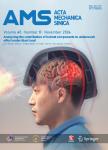Lagrangian-based investigation of multiphase flows by finite-timeLyapunov exponents
Lagrangian-based investigation of multiphase flows by finite-timeLyapunov exponents作者机构:School of Aerospace EngineeringBeijing Institute of Technology100081 Beijing China Department of Mechanical and Electro-Mechanical EngineeringNational Taiwan Sun Yat-Sen UniversityKaohsiung Taiwan China Department of Aerospace EngineeringUniversity of Michigan Ann ArborM148109 USA
出 版 物:《Acta Mechanica Sinica》 (力学学报(英文版))
年 卷 期:2012年第28卷第3期
页 面:612-624页
核心收录:
学科分类:080701[工学-工程热物理] 07[理学] 08[工学] 0807[工学-动力工程及工程热物理] 070201[理学-理论物理] 0702[理学-物理学]
主 题:Finite-time Lyapunov exponents Lagrangiancoherent structures Multiphase flow Gaseous jets injectedinto water Cavitation
摘 要:Multiphase flows are ubiquitous in our daily life and engineering applications. It is important to investigate the flow structures to predict their dynamical behaviors ef- fectively. Lagrangian coherent structures (LCS) defined by the ridges of the finite-time Lyapunov exponent (FTLE) is utilized in this study to elucidate the multiphase interactions in gaseous jets injected into water and time-dependent turbu- lent cavitation under the framework of Navier-Stokes flow computations. For the gaseous jets injected into water, the highlighted phenomena of the jet transportation can be observed by the LCS method, including expansion, bulge, necking/breaking, and back-attack. Besides, the observation of the LCS reveals that the back-attack phenomenon arises from the fact that the injected gas has difficulties to move toward downstream re- gion after the necking/breaking. For the turbulent cavitating flow, the ridge of the FTLE field can form a LCS to capture the front and boundary of the re-entraint jet when the ad- verse pressure gradient is strong enough. It represents a bar- rier between particles trapped inside the circulation region and those moving downstream. The results indicate that the FFLE field has the potential to identify the structures of mul- tiphase flows, and the LCS can capture the interface/barrier or the vortex/circulation region.



